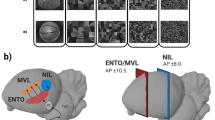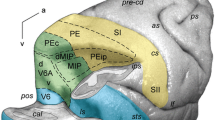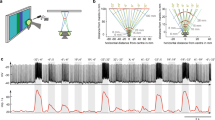Summary
Quantitative behavioral experiments demonstrated that toads discriminate moving prey and enemy objects mainly by two surface parameters: (i)Object expansion in the direction of movement generally means “prey” (Fig. 7Ca) while (ii)expansion perpendicular to the direction of movement signifies “not prey” or “enemy” (Fig. 7Cb). Single unit recordings along the central visual path should answer the question as to whether there are neuronal nerve nets responsible for processing those behaviorally relevant surface parameters of moving visual objects (Figs. 1 and 2).
-
1.
In the thalamus/pretectal region (mainly the caudal dorsal thalamus; see Fig. 3) units with circular excitatory receptive fields (ERF) of about 46 ° diameter were investigated. During successive experiments the discharge rate of these neurons was increasing only when the expansion of an object — moved through the center of the receptive field—was increased perpendicularly to the direction of motion, (Figs. 5Ab, c and 6A). (The stimulus parameters of contrast and angular velocity were held constant.)
-
2.
In the optic tectum (stratum griseum et album centrale; see Fig. 4), units were identified showing circular ERFs of about 27 ° diameter. Some of these neurons (tectum 1 neurons) were activated mainly by increasing object expansion in the direction of movement (Figs. 5Ba, c and 6B).
-
3.
Other units of the same tectal layer (tectum 2 neurons) differed from tectum 1 neurons as follows: The discharge rate diminished according to the increasing surface expansion of the stimulus object perpendicular to the direction of movement. The response of those neurons “reflected” the key stimulus “prey” (Figs. 5C and 6C; compare Figs. 7 B and C).
-
4.
It is supposed that prey/enemy recognition is a result of subtractive and additive interactions between tectal and thalamus/pretectal “gestalt” filters (Fig. 8). The response characteristic of tectum 2 neurons to the size of a moving stimulus may be the result of excitatory inputs from tectum 1 and inhibitory from thalamus/ pretectal neurons (Fig. 8; compare Figs. 7 A and B). Presumably those units (Fig. 7 B) act as a “trigger system” for the prey-orienting movement (Fig. 7C).
Zusammenfassung
Frühere quantitative Verhaltensexperimente hatten ergeben, daß die Kröte für die Unterscheidung „Beute/Feind” hauptsächlich zwei Flächen-parameter eines bewegten Objektes nutzt: (a) die Objektausdehnungin der Bewegungsrichtung — sie bedeutet generell Beute; (b) die Ausdehnungquer zur Bewegungsrichtung — sie bedeutet generell „keine Beute” oder „Feind”. Mit Hilfe von Einzelzellableitungen wurde geprüft, ob es im zentralen visuellen System der Kröte Neurone gibt, die an der Auswertung solcher Gestaltparameter beteiligt sind.
-
1.
In der Thalamus/Praetectum-Region (überwiegend caudaler dorsaler Thalamus) wurden Neurone mit zirkulären excitatorischen rezeptiven Feldern (ERF) von ca. 46 ° ø quantitativ untersucht. Wenn man unterschiedliche rechtwinklige Objekte durch das rezeptive Feldzentrum bewegte, so stieg die neuronale Entladungsrate in successiven Versuchen lediglich mit zunehmender Ausdehnung eines Objektsquer zur Bewegungsrichtung an. (Die Werte für die Parameter Kontrast und Winkelgeschwindigkeit wurden konstant gehalten.)
-
2.
Im Tectum opticum (Stratum griseum et album centrale) konnten Neurone identifiziert werden, die ein zirkuläres, ca 27 ° gro\es ERF hatten. Einige von ihnen (Tectum-1-Neurone) gaben hauptsächlich Objektausdehnungenin der Bewegungsrichtung durch Modulation ihrer Entladungsrate an; hierbei erhöhte sich die Entladungsrate — in Grenzen — mit zunehmender Ausdehnungskomponente der Reizfläche.
-
3.
Andere Einheiten aus denselben Tectum-Schichten (Tectum-2-Neurone) unterschieden sich von den ersten hauptsächlich dadurch, daß die Entladungsrate auf Flächen-Ausdehnungskomponentenquer zur Bewegungsrichtung gesenkt wurde. Ihre Antwortcharakteristik „spiegelte” sehr gut den Schlüsselreiz „Beute” wider.
-
4.
Es wird vermutet, daß der Beute/Feind-Erkennungsprozeß auf subtraktiver und additiver Interaktion zwischen den tectalen und thalamus-praetectalen „Gestalt”-Filtern beruht. Hierbei könnte sich die Antwortcharakteristik von Tectum-2-Neuronen für unterschiedliche Flächenmuster durch erregende Eingänge von Tectum-1- und hemmende Eingänge von Thalamus/Praetectum-Neuronen ergeben.
Similar content being viewed by others
Literatur
Autrum, H.: Das Fehlen unwillkürlicher Augenbewegungen beim Frosch. Naturwissenschaften46, 435 (1959)
Birukow, G., Meng, M.: Eine neue Methode zur Prüfung des Gesichtsinnes der Amphibien. Naturwissenschaften42, 652–653 (1955)
Ewert, J. -P.: Der Einfluß von Zwischenhirndefekten auf die Visuomotorik im Beutefang- und Fluchtverhalten der Erdkröte (Bufo bufo L.). Z. vergl. Physiol.61, 41–70 (1968)
Ewert, J. -P.: Neural meehanisms of prey-catching and avoidance behavior in the toad (Bufo bufo L.). Brain Behav. Evol.3, 36–57 (1970)
Ewert, J. -P.: Lokalisation und Identifikation im visuellen System der Wirbeltiere. Fortschr. Zool.21, 307–333 (1973)
Ewert, J. -P.: The neural basis of visually guided behavior. Sci. Amer.230, 34–42 (1974)
Ewert, J. -P., Borchers, H. -W.: Reaktionscharakteristik von Neuronen aus dem Tectum opticum und Subtectum der ErdkröteBufo bufo (L.). Z. vergl. Physiol.71, 165–189 (1971)
Ewert, J.-P., Borchers, H.-W.: Inhibition of toad (Bufo bufo L.) retinal on-off and off ganglion cells via active eye closing. Vision Res. (in press) (1974)
Ewert, J. -P., Gebauer, L.: Größenkonstanzphänomene im Beutefangverhalten der Erdkröte (Bufo bufo L.). J. comp. Physiol.85, 303–315 (1973)
Ewert, J. -P., Hock, F. -J.: Movement sensitive neurons in the toad's retina. Exp. Brain Res.16, 41–59 (1972)
Ewert, J.-P., Hock, F. -J., Wietersheim, A. v.: Thalamus, Praetectum, Tectum: Retinale Topographie und physiologische Interaktionen bei der KröteBufo bufo (L.). J. comp. Physiol. im Druck (1974)
Ewert, J. -P., Seelen, W. v.: Neurobiologie und Systemtheorie eines visuellen Muster-Erkennungsmechanismus bei Kröten. Kybernetik14, 167–183 (1974)
Ewert, J.-P., Siefert, G.: Neuronal correlates of seasonal changes in contrast-detection of prey-catching behaviour in toads (Bufo bufo L.). Vision Res. (in press) (1974)
Ewert, J. -P., Wietersheim, A. v.: Der Einfluß von Thalamus/Praetectum-Defekten auf die Antwort von Tectum-Neuronen gegenüber bewegten visuellen Mustern bei der KröteBufo bufo (L.). J. comp. Physiol.92, 149–160 (1974)
Gaze, R. M.: The representation of the retina on the optic lobe of the frog. Quart. J. exp. Physiol.43, 209 (1958)
Grüsser, O. -J., Grüsser-Cornehls, U.: Die Neurophysiologie visuell gesteuerter Verhaltensweisen bei Anuren. Verh. dtsch. zool. Ges. Köln64, 201–218 (1970)
Grüsser, O. -J., Klinke, R. (Hrsg.): Zeichenerkennung durch biologische und technische Systeme. 413 S. Berlin-Heidelberg-New York: Springer 1971
Hubel, D. H., Wiesel, T. N.: Receptive fields binocular interaction and functional architecture in the cat's visual cortex. J. Physiol. (Lond.)160, 106–154 (1962)
Ingle, D.: Prey-catching behavior of anurans toward moving and stationary objects. Vision Res.3, 447–456 (1971)
Ingle, D.: Disinhibition of tectal neurones by pretectal lesions in the frog. Science180, 422–424 (1973 a)
Ingle, D.: Evolutionary perspectives on the function of the optic tectum. Brain Behav. Evol.8, 211–237 (1973 b)
Knapp, H., Scalia, F., Riss, W.: The optic tracts ofRana pipiens. Acta neurol. scand.41, 325–355 (1965)
Lázár, Gy., Székely, G.: Distribution of optic terminals in the different optic centers of the frog. Brain Res.16, 1–14 (1969)
Lettvin, J. Y., Maturana, H. R., McCulloch, W. S., Pitts, W. H.: What the frog's eye tells the frog's brain. Proc. Inst. Radio Engrs. N.Y.47, 1940–1951 (1959)
McIlwain, J. T.: Central vision: visual cortex and superior colliculus. Ann. Rev. Physiol.34, 291–314 (1972)
Riss, W., Pedersen, R. A., Jakway, J. S., Ware, C. B.: Levels of function and their representation in the vertebrate thalamus. Brain Behav. Evol.6, 26–41 (1972)
Schneider, D.: Beitrag zu einer Analyse des Beute- und Fluchtverhaltens einheimischer Anuren. Biol. Zbl.73, 225–282 (1954)
Author information
Authors and Affiliations
Additional information
Mit Unterstützung der Deutschen Forschungsgemeinschaft, Ew 7/6 und Forsch.-Gr. Az.: 741,29.
Rights and permissions
About this article
Cite this article
Ewert, J.P., von Wietersheim, A. Musterauswertung durch Tectum- und Thalamus/Praetectum-Neurone im visuellen System der KröteBufo bufo (L.). J. Comp. Physiol. 92, 131–148 (1974). https://doi.org/10.1007/BF00694502
Received:
Issue Date:
DOI: https://doi.org/10.1007/BF00694502




